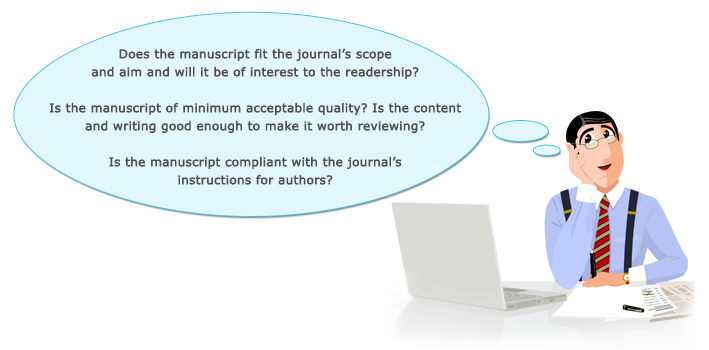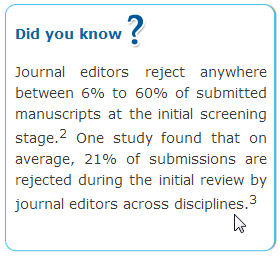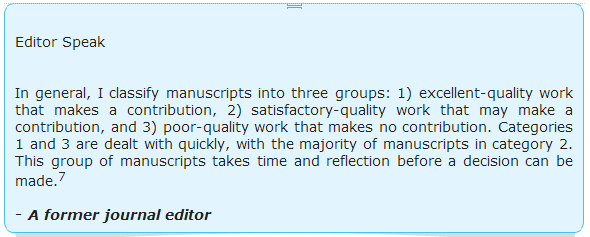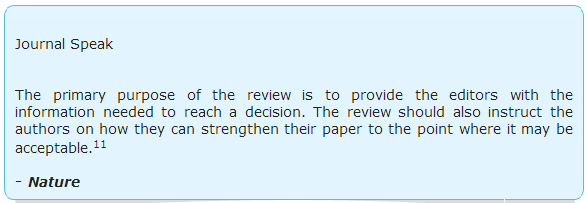Peer review process and editorial decision making at journals
Status descriptions in journal submission systems
Once a paper is submitted to a journal, the author can track its progress through the online submission system of the journal. However, status descriptions are often journal specific and can be confusing for authors. Authors usually feel anxious, making it even more difficult for them to interpret the status descriptions and decide the right course of action after each status change. This series of posts helps authors understand different status descriptions and their meanings.

Key takeaways:
- Peer review is the process by which journals scrutinize and regulate the quality of content they publish, by inviting experts in the field to review and comment on manuscripts received.
- Manuscripts submitted to a journal first go through an initial screening by the editorial team.
- Those that clear the screening are sent to at least two experts for peer review.
- Peer reviewers independently make a recommendation to the journal editor as to whether the manuscript should be rejected or accepted (with or without revisions).
- The journal editor considers all the feedback from peer reviewers and makes an informed decision to accept or reject the manuscript.
This article was originally published in 2013 and is being recirculated as part of Peer Review Week 2021.
The peer review process for journal publication is essentially a quality control mechanism. It is a process by which experts evaluate scholarly works, and its objective is to ensure a high quality of published science. However, peer reviewers do not make the decision to accept or reject papers. At most, they recommend a decision. At peer-reviewed journals, decision-making authority rests solely with journal editors or the journal’s editorial board. Indeed, it is the journal editor who is considered to be central to the decision making process.1
Journal decision-making process
Typically, after a paper is submitted to a journal, a journal editor screens the manuscript and decides whether or not to send it for full peer review. Only after clearing the initial screening is the manuscript sent to one or more peer reviewers. Finally, journal editors or the journal’s editorial board consider the peer reviewers’ reports and make the final decision to accept or reject the manuscript for publication.

Initial screening
Approximately 3 million manuscripts are submitted to journals every year.1 Given the large volume of manuscript submissions, more and more journals follow a policy of screening papers before sending them for full peer review. During the initial screening, journal editors mainly check the following:

Journal editors typically look at hundreds of manuscripts a year. One of the first items that editors will look at is the cover letter, and they may not get further than the cover letter if the study does not seem interesting enough. Therefore, it is imperative that authors craft a well-written cover letter that highlights the significance and strength of their research as well as provides a good reason why the manuscript is a good fit for the journal. Editors will then go through the abstract and may even skim through the introduction, figures and tables, or other sections of the paper to determine whether the manuscript passes their quality threshold.
Benefits of initial screening:
- If the manuscript clearly lies outside the scope of the journal, then a rapid rejection allows the author to quickly find and submit their manuscript to another journal.
- Peer reviewers’ time is wasted when they have to spend time evaluating and giving feedback for a manuscript of clearly inferior quality.
Peer review
Once a manuscript clears the initial screening, it is sent for peer review.
There are three common types of peer review for journal publication:
- Single blind: names of reviewers are not revealed to authors
- Double blind: names of reviewers and authors are not revealed to each other
- Open peer review: Names of authors and reviewers are revealed to each other
Generally, a minimum of 2 peer reviewers (up to 6) are chosen for the peer review. Peer reviewers are ideally experts in their field. Journals usually build a pool of peer reviewers that have a good track record of producing high-quality reviews. Or they may scan the bibliography to identify potential reviewers or contact researchers they met at conferences and seminars.1 Many journals will first ask potential reviewers whether they are willing to review the manuscript before assigning them as reviewers.
Editors have to be careful to select reviewers who have sufficient subject matter expertise to do justice to the manuscript. Therefore, highly technical papers or papers from niche subject areas may take longer to review, because it may take editors some time to locate appropriate reviewers.
Some journals give authors the option of recommending preferred and non-preferred reviewers. Authors would do well to take advantage of this option if available as it can expedite the review process, since it saves the journal time in looking for reviewers. Furthermore, studies have found that author recommended peer reviewers tend to recommend acceptance more often than journal recommended reviewers.4,5
The peer review is completed once all the reviewers send the journal a detailed report with their comments on the manuscript and their recommendation. Typically, journals ask reviewers to complete their reviews within 3-4 weeks.6 However, few journals have a mechanism to enforce the deadline, which is why it can be hard to predict how long the peer review process will take.6
Final decision
The journal editor or editorial board considers the feedback provided by the peer reviewers and arrives at a decision. The following are the most common decisions that are made:
- accept without any changes (acceptance): the journal will publish the paper in its original form
- accept with minor revisions (acceptance): the journal will publish the paper and asks the author to make small corrections
- accept after major revisions (conditional acceptance ): the journal will publish the paper provided the authors make the changes suggested by the reviewers and/or editors
- revise and resubmit (conditional rejection): the journal is willing to reconsider the paper in another round of decision making after the authors make major changes
- reject the paper (outright rejection): the journal will not publish the paper or reconsider it even if the authors make major revisions
The first option (accept without any changes) is rare. The second decision (accept with minor revisions) is typically the best outcome authors should hope for. Once a journal rejects a paper outright, authors are well advised not to resubmit to the same journal. If the journal wanted to reconsider the paper, they would have issued a conditional rejection. An outright rejection means that the journal thinks the paper will not meet its publication standards or interests even after heavy revisions.

Do peer reviewers and editors always agree on what's worthy of publication?
Editors’ decision-making policies vary: some reject when even one peer reviewer recommends rejection, some when the majority recommend rejection, and some only when all reviewers recommend rejection.2
It is common for peer reviewers to give conflicting feedback on the same manuscript.8,9 One journal editorial went as far as to say “Unanimity between reviewers is rare.”10 In cases of conflicting feedback, the journal editor may choose to send the paper to a third reviewer before arriving at a decision, and the author may have to wait longer for the peer review process to be completed.
In reality, reviewers tend to recommend acceptance more often than rejection.10 Thus, journal editors end up rejecting many papers that peer reviewers actually recommended for publication, with their decisions based on their own opinions of the papers’ publication worthiness. The role of peer review is considered to be helping authors improve their manuscripts rather than deciding whether they should be published, which is the journal editor’s job.

Conclusion
Because of a large number of submissions, top-tier journals are often forced to reject even high quality manuscripts for various reasons, like a large number of submissions or lack of fit with the journal’s editorial focus.2 While reviewers and editors easily agree on what is clearly not acceptable for publication, deciding what is worthy of publication is a tougher challenge.12 Finally, journal editors make decisions to accept or reject papers based on their opinion of the papers’ publication worthiness and reviewers’ comments.10
Click here to view a short presentation on this topic!
Also see the following questions in our Q&A forum about the journal editorial process:
- What are the first things journal editors look at in a submission package?
- How long should I wait for a response from the journal?
- What is the meaning of "decision in process" status?
- House of Commons Science and Technology Committee (2011). Peer review in scientific publications Vol 1. House of Commons: London, UK.
- Schultz DM (2010). Rejection rates for journals publishing in the atmospheric sciences. Bulletin of the American Meteorological Society, 91(2): 231-243. doi: 10.1175/2009BAMS2908.1.]
- Thomson Reuters (2011). Increasing the quality and timeliness of peer review: A report for scholarly publishers [white paper]. Available at: http://scholarone.com/media/pdf/peerreviewwhitepaper.pdf
- Hutchings A (2006). Differences in review quality and recommendations for publication between peer reviewers suggested by authors or by editors. JAMA, 295(3): 314-317.
- Wager E, Parkin EC, Tamber PS (2006). Are reviewers suggested by authors as good as those chosen by editors? Results of a rater-blinded, retrospective study. BMC Medicine, 4: 13. doi: 10.1186/1741-7015-4-13.
- Association of Learned and Professional Society (2000). Current practice in peer review. Results of a survey conducted during Oct/Nov 2000. Association of Learned and Professional Society Publishers: Worthing, UK.
- Samet JM (1999). Dear author-advice from a retiring editor. American Journal of Epidemiology, 150(5): 433-436.
- Rothwell PM & Martyn CN (2000). Reproducibility of peer review in clinical neuroscience: Is agreement between reviewers any greater than would be expected by chance alone? Brain, 123(9): 1964–9.
- Ray JG (2002). Judging the judges: The role of journal editors (editorial). Quarterly Journal of Medicine, 95: 769-74.
- Coronel R (1999). The role of the reviewer in editorial decision-making. Cardiovascular Research, 43(2): 261-64. doi: 10.1016/S0008-6363(99)00177-7.
- Nature. Peer-review policy. Last accessed August 4, 2011. Available at: http://www.nature.com/authors/policies/peer_review.html
- Howard L & Wilkinson G (1999). Peer review and editorial decision-making. Neuroendocrinology Letters, 20(5): 256-260.
Published on: Nov 04, 2013
Comments
You're looking to give wings to your academic career and publication journey. We like that!
Why don't we give you complete access! Create a free account and get unlimited access to all resources & a vibrant researcher community.

Subscribe to Journal Submission & Peer Review

















